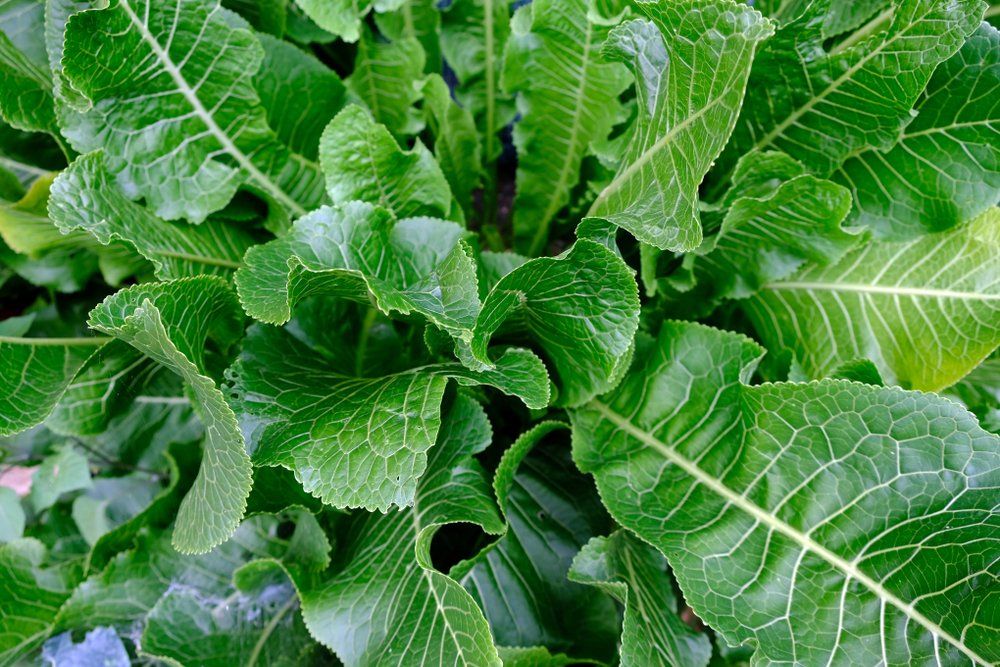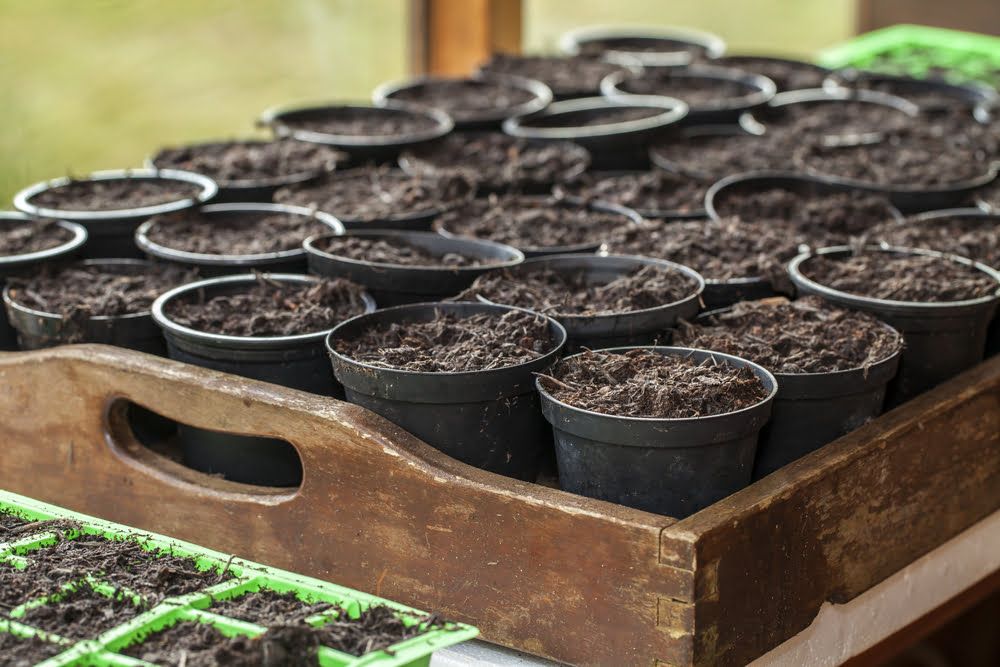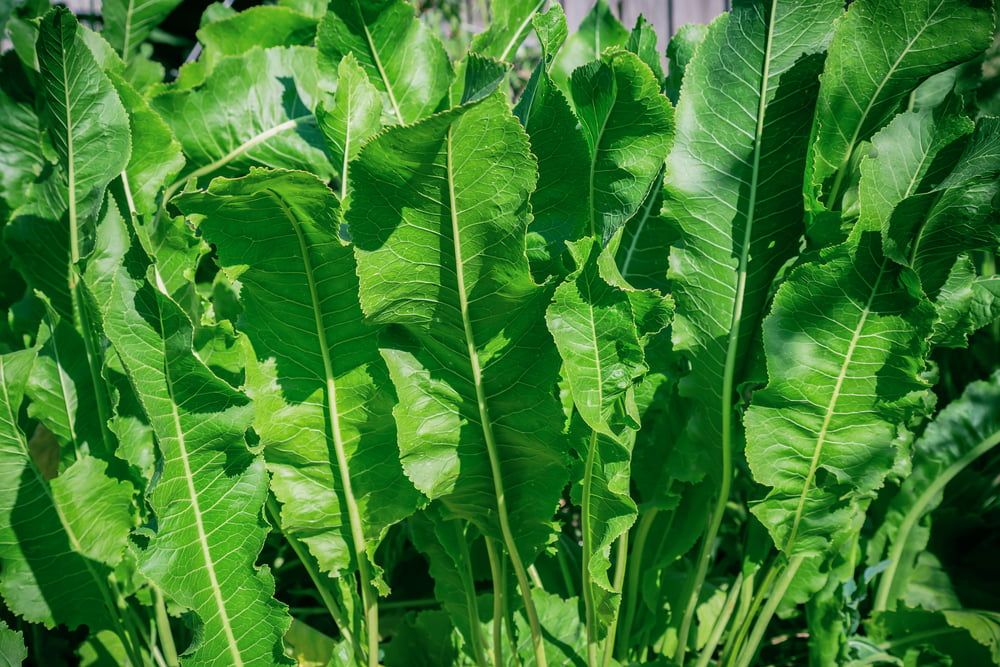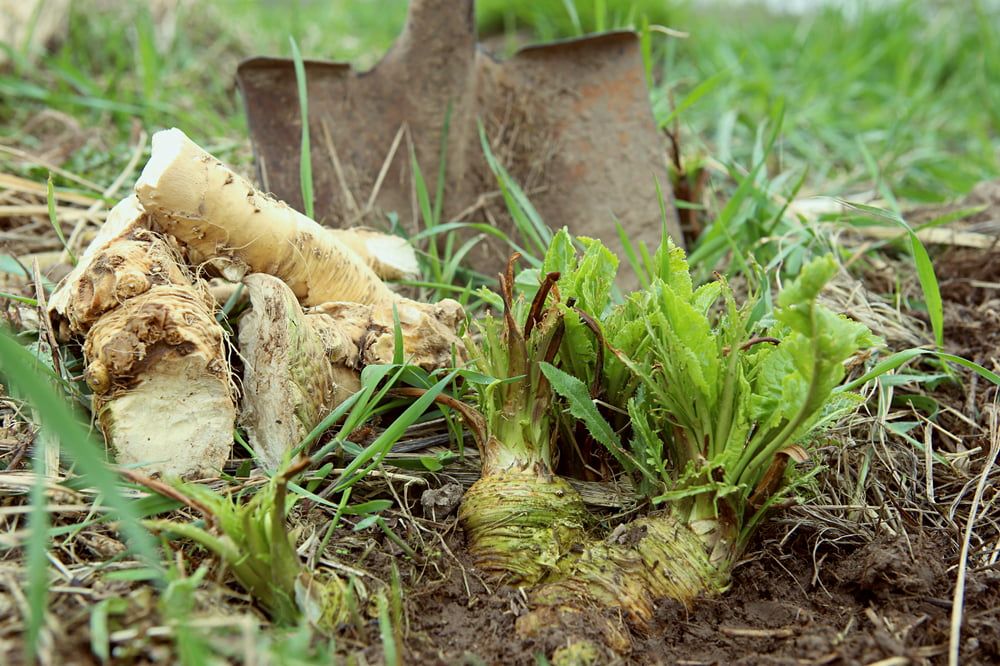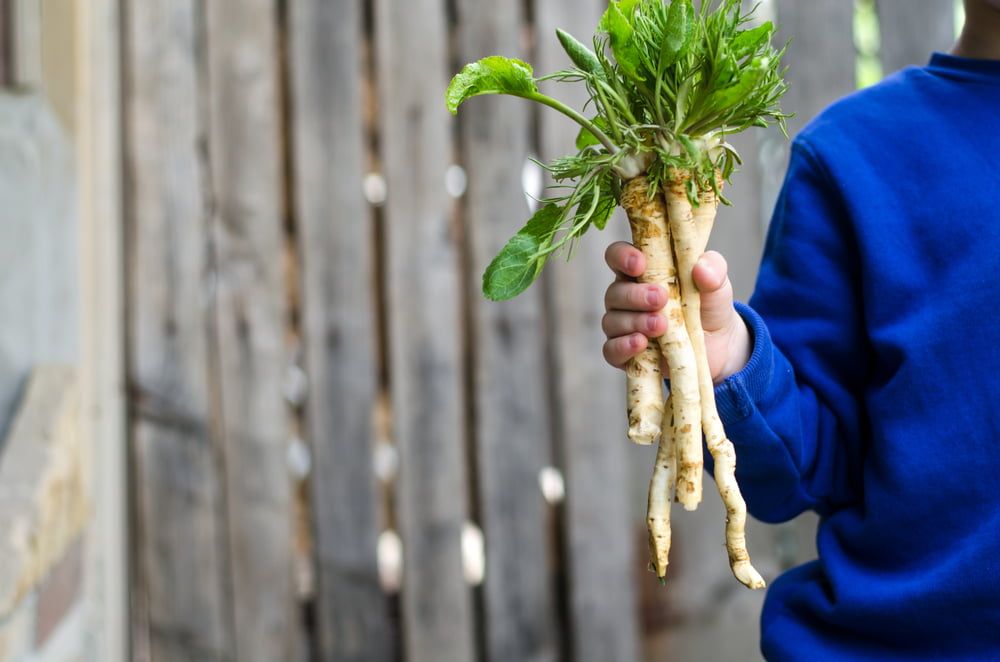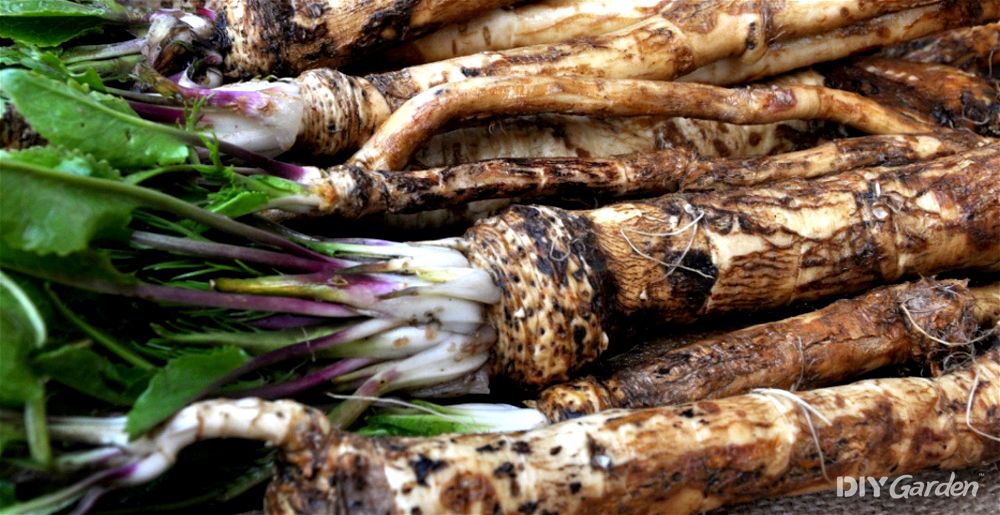
Many gardeners would agree that horseradish is one of the easiest perennial crops to grow. In fact, once you have an established horseradish patch, those long roots are near-impossible to ever completely get rid of it, so choose your location wisely. Sweet yet distinctively pungent, fresh horseradish will provide your meals with an intense kick, with only a minimal amount of effort needed from you.
Growing Horseradish: A Quick Snapshot
When to Sow – Jan-Mar
When to Plant – Mar-Apr
When to Harvest – Oct-Mar
Average Yield per Plant – 0.25kg/year
Spacing – 60-90cm
Depth – 5cm
How to Grow Horseradish at Home
Horseradish is so easy to grow, to the point where many would consider it to be an invasive plant. However, it also produces a delicious crop of roots, and just a small amount of advance planning will enable you to prevent it from taking over.
When it comes to growing conditions, horseradish prefers to be in the sun but will do well in partial shade too.
Horseradish isn’t fussy about soil type. However, in order for those roots to grow straight and strong, your soil should be relatively loose, without too many stones.
Horseradish tolerates just about everything apart from constantly wet and boggy soils, making this a crop suitable for every garden!
Horseradish Seeds vs Horseradish Crowns/Root Cuttings
Although horseradish can be grown from seed, most gardeners tend to plant root cuttings, officially known as thongs. These will establish themselves quickly, requiring very little care once planted.
Horseradish roots can be planted in early spring, before your last frost has made an appearance. However, plants grown from seeds are a little more delicate – you’ll need to wait until just after your last frost before planting these out.
Of course, just like with almost every other plant, crowns tend to be more expensive than seeds.
Containing Horseradish
Once established, horseradish is extremely difficult to get rid of. It will spread more and more each season from its deep underground roots. In fact, if you leave it undisturbed in fertile soil, its roots can grow up to 3m in length, producing a number of secondary roots that are just as long.
Yes, you can try to dig horseradish up, but even the tiniest root cutting will produce new plants.
For this reason, unless you have a large garden or plot, it may be worth considering growing your horseradish in a bucket-sized container. This limits the depth at which each tap root can grow to. You can then submerge your container into the ground and cover it over with soil, so that the horseradish blends in well with the rest of your garden.
Alternatively, if you want to plant horseradish in the ground, pick an unused area of your garden. You could also create a raised bed for your horseradish plants.
How to Grow Horseradish from Seed
If you want to start your horseradish seeds in pots or trays, then seeds should be sown early in the year – January or February is perfect. Seeds can also be sown directly outdoors, but this should be done in March. While sowing direct is a lower-maintenance method, starting seeds in trays gives you better control over how the plant grows and progresses.
Sowing Horseradish Seeds in Pots/Trays
Once germinated, horseradish will grow quite quickly. For this reason, it’s best to start with 7-9cm pots, rather than shallow trays. This will save you from having to repot before transplanting outside.
Fill your pots with a rich, multi-purpose compost and water well. Then, place a horseradish seed over the top of each pot before covering over with about 1cm of compost. Water lightly and place in a sheltered spot.
Horseradish seeds don’t need heat in order to germinate. They’ll sprout in soil temperatures as low as 7°C, and don’t actually do well in temperatures above 23°C.
It will take about one to two weeks for your horseradish seeds to germinate. At this point, simply keep them watered and make sure that they’re getting plenty of light. Once you’ve had your last frost, you can then plant them out.
Directly Sowing Horseradish Seeds Outside
Sowing horseradish seeds directly outside will save you from having to transplant them from pots. This minimises root disturbance, allowing the seedlings to really thrive.
However, wait until March before sowing horseradish seeds directly outdoors.
Start by loosening the soil in your planting location, removing as many stones and obstacles as you can. Then, sow your seeds about 5cm deep before covering them over.
Once seedlings start to appear, you’ll need to thin them out so that there’s at least 30cm between them. Then, when the seedlings are about 10cm tall, you can do a final thinning so that they are 60-90cm apart.
How to Plant Horseradish Outside
If you’re planting pot-grown seedlings outside, wait until after your last frost.
Then, it’s simply a case of loosening the soil in your planting bed and transplanting your potted plant into its new home.
Again, keep plants about 60-90cm apart, and plant them at the same depth as their current pot.
Planting Horseradish Thongs Outside
If you would prefer to start your horseradish from thongs, rather than from seeds, then these should be planted straight outside. Do this as soon as you receive your thongs, even if you still have a couple of months until your last frost in the spring.
There are a few different methods for planting horseradish thongs outside. There’s no saying which works best, so choose the method that appeals to you the most:
- If your thongs are small, you can plant them in rows by digging shallow trenches that are about 5-6cm deep and then covering over with soil.
- Sit the crowns at soil level. They will produce new roots that delve downwards into the soil.
- Plant each crown into a hole, standing it vertically, narrow end down, at a 45-degree angle, before covering over.
Whichever method you choose, remember to keep your horseradish plants about 60-90cm apart. It may be difficult to imagine them this large when you first get started, but it really won’t be long before they reach their mature size.
How to Plant Horseradish in a Greenhouse
Since horseradish prefers cooler conditions, it’s always better to plant it outside instead of in a greenhouse. However, if you want to give greenhouse growing a try, keep your horseradish in containers to prevent it from taking over your greenhouse.
Horseradish will grow in containers of just about any size, but, for maximum harvests, go for something at least 60cm deep. This will allow the roots to grow to full size.
How to Care for Horseradish
In addition to being highly productive, your horseradish will be among the easiest of your crops to care for.
Watering Horseradish
The rain usually provides horseradish with all of the water it needs. This equates to about 1-2cm of water a week.
If you’re experiencing a long dry spell, then you may want to give your horseradish a weekly watering. This isn’t strictly necessary – the plants will make it through periods of drought, but this will give them a woodier texture and a duller flavour. On the other hand, too much water will soften the roots and turn their flavour a bit too pungent, so don’t be too heavy-handed with the watering can.
Weeding Horseradish
If you want your horseradish plants to be at their very best, then weed the area around them. This means that they won’t have to deal with competition for water, nutrients, and sunlight, allowing them to reach their full potential.
However, horseradish is a strong and vigorous plant. Weeds may slow down initial growth slightly, but your horseradish will likely soon drown the weeds out.
A mulch is always useful for keeping weeds at bay. This will also help to maintain consistent moisture and temperature levels for your horseradish plants.
Fertilising Horseradish
Horseradish is so naturally vigorous that it doesn’t usually need to be fertilised.
The only exception to this would be if you’re growing it in very poor quality soil, yet need a large harvest. Pot-grown plants will also benefit from a feed. Apply a well-balanced, granular fertiliser to the soil around your horseradish plants in the spring, after you’ve spotted new leaf growth.
How to Harvest Horseradish
Although most grow horseradish for its roots, its leaves can be eaten too. They taste like a mix between kale and rocket – they’re peppery and slightly bitter, with a great texture.
Young leaves are the mildest, while larger and older leaves will have a much stronger flavour.
Horseradish greens are a great addition to any diet, but picking the leaves will inhibit root growth, so harvest them in moderation.
When it comes to harvesting your horseradish roots, this is best done in the autumn. Wait until all of the foliage has died back, and, if possible, until you’ve had a frost or two. This will help to improve the flavour of the roots. While this may be the best time for a large harvest, you can continue harvesting your plants until the spring.
To harvest the roots, you’ll need to dig up the entire horseradish plant. Use a spade to dig around the roots, before lifting the plant out of the ground.
Then, separate out the largest root sections – these are the ones that you’ll be using in the kitchen. All of those small and spindly roots can be immediately planted back into the ground. You may think that it makes more sense to replant the larger roots instead, but these will actually turn quite woody by your next harvest, making it best to use those straight away.
If you don’t want to immediately replant, you can store your saved root sections for planting in the spring. Place them in damp sand or sawdust and keep them in a dark, cool, and dry location for the winter.
How to Store Horseradish
As soon as it has been harvested, horseradish starts to dry up. You can pack your roots into damp sand or sawdust to keep them for up to 10 months, but don’t expect the same texture and flavour as fresh horseradish roots.
Alternatively, the fresh roots can be grated and then stored in the fridge. They’ll retain maximum intensity for a couple of weeks, but can still be used for about four months. Mixing in a couple of teaspoons of lemon juice or vinegar will help to prolong their shelf life.
If you grate and freeze your horseradish roots, then they will last even longer.
How to Prepare & Cook Horseradish
To prepare horseradish, begin by washing the roots that you want to use. You will then need to peel them.
The most common way to use fresh horseradish is in grated form, but be warned that the fumes released during the grating process are extremely pungent!
A hand grater works well, or you can use a food processor. Either way, do this by a window or outside on a breezy day, ensuring that all of those fumes are blowing away from you!
Using Horseradish in the Kitchen
Grated horseradish is usually used raw. The cooking process reduces the smell and intensity of the process, so, if you do want to add it into cooked dishes, do this at the very end.
Other than that, try using horseradish in the following ways:
- As an accompaniment to roast meats or sushi
- In sandwiches
- For flavouring stews and soups
- Mixing it into a creamy sauce
- Mashing it with potatoes
- Making a horseradish butter
- Adding it to salad dressings
Common Horseradish Problems
Horseradish is a hardy plant. It usually defends itself well against pests and diseases, meaning that most gardeners won’t face any problems when growing horseradish.
You may notice some pests feasting on your horseradish leaves – slugs and aphids in particular really enjoy them. However, they don’t tend to cause enough damage to affect the roots, making manual control all you need.
Popular Horseradish Varieties to Grow
Horseradish is divided into two main types:
- Common Horseradish – broad leaves and excellent root quality
- Bohemian Horseradish – narrow leaves with smaller and less flavourful roots
While Bohemian Horseradish is said to have better disease-resistance, most gardeners don’t experience disease issues with Common Horseradish anyway, making this the best type to plant.
Conclusion
Horseradish is an easy and low-maintenance crop to grow – once you plant some, you’ll never need to buy it again! The main downside is its tendency to sometimes get a little invasive, but choose the right planting spot and you shouldn’t have any problems.
